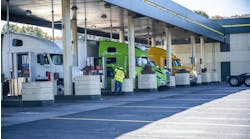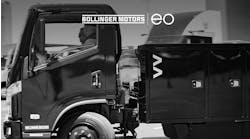“At the end of the day, Ferrellgas is a logistics company,” said Mike Abrams, vice president of fleet and asset management. “We deliver a product on schedule. In our case, it just happens to be propane.”
Ferrellgas, based in Liberty, MO, serves customers in all 50 states, the District of Columbia, and Puerto Rico. The company fields about 3,400 trucks, including over 3,000 Class 5-7 models that make residential and business propane deliveries. The balance of the fleet consists of a variety of Class 2-5 units.
“The right truck specification decisions are essential for Ferrellgas,” Abrams stated. “We operate delivery trucks for 10 to 15 years, so durability and reliability are key concerns. Our trucks might only cover 25,000 miles a year, but when you consider the stop-and-go nature of our business and the amount of time the engines run powering PTO-driven pumps at delivery locations, it’s the same amount of wear you’d see over one million miles in an on-highway operation.
“Propane delivery service is a tough environment for a truck,” Abrams continued. “Our vehicles start the day fully loaded to 33,000 lbs. and even after they’ve delivered all the product they carry, they still weigh about 17,000 lbs. due to the heavy propane barrels.”
Among the medium-duty trucks in the Ferrellgas fleet, over 35% are Kenworths, including newer T370s. The balance of the units includes Freightliners, Internationals, Volvos, and other models. The Class 7s are fitted with 3,000- and 3,200-gallon propane tanks that meet MC 331 specs for the transportation of compressed gases.
Ferrellgas replaces truck chassis based on age, mileage, maintenance needs, and new-unit costs. The fleet grows through acquisitions, and additions are made each year to meet projections of the assets needed to serve customers. Some tanks are also reused when chassis are replaced.
“Our trucks are purchased directly from OEMs, but we work closely with dealers, such as MHC Kenworth in Kansas City for our newest models,” Abrams related. “Prior to coming off the production line, the dealers coordinate with OEM engineers and upfitters.
“With their help, we can focus on specs to help ensure reliability and durability,” Abrams continued. “Truck service life is critical for us because the cost to change out propane tanks is significant. A barrel has a 30- to 35-year life, so if we can reduce the number of changeouts, we can save a substantial amount of money.”
Supplier relationships are also central to the nationwide support network that provides maintenance and repair services for the widespread Ferrellgas fleet. The company coordinates service through a third-party fleet management company.
“We use dealer locations and independent providers,” Abrams explained. “For example, with Paccar and Cummins we have a wide network of coverage. We also operate in a lot of rural communities, so we rely on long-term established relationships with local businesses as well.”
Internally, after many months of study, Ferrellgas is now implementing new software for managing a comprehensive list of fleet functions. “We worked with our IT department to develop a list of criteria and asked a number of fleet and asset software providers to self-assess how their systems meet our needs,” Abrams said. “We then asked the providers to demonstrate their products.”
After several rounds of demonstrations and tests, Ferrellgas settled on FleetWave software from Chevin Fleet Solutions. “They consistently met every need on our checklist,” Abrams stated. “FleetWave is an off-the-shelf system that is also customizable and will easily integrate with several provider systems we have in place for maintenance, fuel, tires, and other management functions.”
Ferrellgas is also using next-generation onboard technology to manage planning, routing, and tracking as well as delivery operations. The program was initially rolled out a number of years ago and now includes things like handheld devices designed to gather delivery data and make drivers’ lives easier.
“Our goal is to build a consolidated single source of fleet information that will give us visibility and detailed analysis tools to manage our fleet more efficiently,” Abrams stated. “There are opportunities to grow and simultaneously consolidate and more effectively allocate resources. The need to operate a highly specialized fleet for many years poses challenges, but those can be addressed successfully with the right information.”



